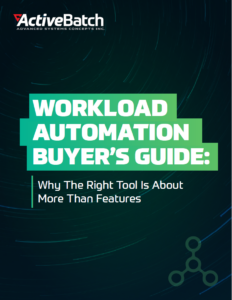Distributed Job Schedulers: An Overview To Building Your Own

What are Distributed Job Schedulers?
Distributed job schedulers are software solutions capable of launching unattended scheduled jobs or workloads across multiple servers.
For example, a distributed scheduler can be installed on one or more machines, through which a user can schedule tasks to run on servers A, B, C, and D. The user can chain these tasks together into a single job, so that a successful execution of server A tasks will trigger tasks to run on server B, and so on. This would be a distributed workflow.
Distributed tasks can be either periodic or ad hoc. For example, users can schedule jobs to execute periodically (every hour, every day, every second Tuesday, etc.) or as one-off executions (retrieving files for a custom report). Distributed scheduling systems also support parallel jobs.
Why are Distributed Job Schedulers Necessary?
Decades ago, it was sufficient to have a job scheduler on a machine –such as a mainframe– that could also execute scheduled workloads and batch jobs. As time wore on, however, and those IT environments grew, organizations, departments, and even teams brought in their own servers, databases, and operating systems built on a variety of scripting languages (Java, Python, UNIX, etc.). This resulted in a fragmented approach to job scheduling, with IT teams implementing schedulers and custom scripts for specific silos.
In order to reliably schedule and automate workloads across silos, IT teams can use distributed job schedulers. The best job schedulers can also support multiple specialized servers.
Architecture of a Distributed System
Distributed environments are typically arranged in one of three ways:
- Centralized: A central node distributes jobs to worker or execution nodes, and orchestrates jobs between those execution nodes.
- Decentralized: Multiple central nodes, each with its own subset of the system.
- Tiered: A three-tier architecture, for example, includes a node for the scheduling software, plus a node for the workload to be executed on, and a node for database access.
Additionally, distributed systems can also include decentralized grid computing, where each node is its own subset (both the central node and execution node), and nodes are loosely connected over a network.
In many cases, distributed scheduling systems are decentralized and managed with an open-source project such as cron (Linux/UNIX) or Apache Mesos. Data centers frequently rely on distributed scheduling via tools such as Apache Kafka or MapReduce for managing distributed computing in big data environments.
Options for tiered systems usually include proprietary tools such as enterprise job schedulers which offer greater support and reduce the need for custom scripting.
Building Your Own Distributed Job Scheduler
IT organizations have the option to set up a distributed job scheduler on multiple machines in their environment. Depending on the systems in the tech stack, IT teams can use tools like Microsoft Windows Task Scheduler or CRON to set up jobs.
Creating these distributed systems is a complex, time-consuming and costly process. With each layer and tool that is incorporated into the system, more risk and potential for disruption is created.
IT teams looking to create a reliable and scalable distributed system should consider a tiered approach. By implementing a workload automation platform like ActiveBatch, IT teams have the ability to quickly and securely connect with any application, server or service. Then they can run workflows across multiple systems, easily managing and monitoring them through the central workload automation platform.
Find The Right Solution That Supports Your Long-Term Goals
Find out how to assess workload automation tools and vendors based on your organization’s needs.
Benefits of Distributed Scheduling
The primary benefit of a distributed scheduling system is that it more fault tolerant when compared to a traditional job scheduler. With a traditional scheduling system, the job scheduler is either installed on the execution machine or else communicates with only one execution machine. Either way, if one machine goes down, critical jobs stop running.
Alternatively, if an execution machine goes down in a distributed system, the scheduler(s) can route affected jobs to available machines.
Beyond fault tolerance, the benefits of distributed scheduling depends largely on the scheduling system being used. For instance, cron jobs can be used to establish a distributed scheduling system, but requires complex coding and offers little visibility (unless you want to write more code).
Then there are open-source scheduling systems such as Chronos or Luigi. Here’s Amazon AWS’s opinion on Chronos:
“Although Chronos is a significant step up over manual scripts or cron, it still requires some manual work to implement. Further, because Chronos requires Apache Mesos to manage communications and resource allocation, it requires the installation and configuration of Mesos throughout your network.”
Amazon AWS offers JumpCloud as its own version of distributed scheduling, however, scripting is often necessary when integrating with other technologies.
Extensible, Distributed Scheduling for the Enterprise
Enterprise scheduling platforms are distributed systems with schedulers and execution machines that can be deployed on-premises or in the cloud. These tools often provide native integrations with major vendors (Microsoft, Oracle, IBM, VMware, Amazon) and in some cases provide REST API adapters that make it possible to integrate virtually any tool or technology.
Extensible, distributed systems enable IT to orchestrate jobs, workloads, and resources through end-to-end processes.
By leveraging an extensible platform, IT can realize the full benefits of distributed scheduling:
- Processes, infrastructure, and systems can be monitored from a single pane of glass, with centralized repositories for logging
- End-to-end processes can be developed and iterated without having to rely on custom scripts, accelerating roll-out and reducing human error
- High availability with non-cluster failover to ensure jobs and workloads are completed on schedule even in the event of failure or outage
- Simplified synchronization between processes and environments
Many modern scheduling systems are distributed. But only a few are truly extensible and can support the orchestration of end-to-end processes without the need for custom scripting. As IT environments become more complex and disparate, it will become increasingly critical for IT to have a unified, extensible, distributed scheduling system.
Frequently Asked Questions
Distributed job scheduling is the practice of using one or more job schedulers that can launch unattended scheduled jobs and workloads across multiple servers. It allows users to create both scheduled and ad hoc workflows, which can run in parallel or consecutively.
A distributed scheduler can be installed on one or more machines, and a user can schedule tasks to run on multiple servers. The user can chain these tasks together in one job, so when a task finishes successfully on one server, it will trigger tasks to run on other servers. This creates a distributed workflow.
In a distributed system, a scheduler gives an organization the ability to schedule tasks across multiple applications, servers and services. IT teams can use schedulers to more reliably schedule and automate workloads across an entire tech stack.
There are schedulers that just run on a specific tool or service, such as Microsoft Windows Task Scheduler and CRON. There are also workload automation platforms like ActiveBatch that connect to other applications, systems and services via connectors or an API. These platforms allow IT teams to run processes across multiple endpoints. These platforms can either run the processes or orchestrate jobs run through multiple job schedulers.
Ready to simplify your data warehousing with workload automation?
Schedule a demo to watch our experts run jobs that match your business requirements in ActiveBatch. Get your questions answered and learn how easy it is to build and maintain your jobs.








